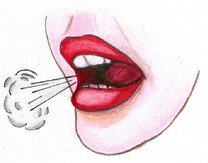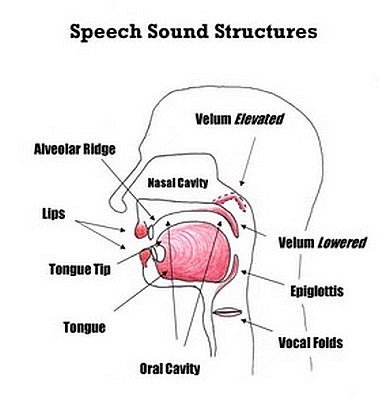Speech Sounds k. How to Elicit the /k/ Sound in Young Children
 Speech sounds k. This webpage gives practical advice on how to elicit the /k/ and /g/ sounds in young children.
Speech sounds k. This webpage gives practical advice on how to elicit the /k/ and /g/ sounds in young children.
Disclaimer: The techniques to be found on this page are written specifically for speech-language clinicians to use with their clientele. Teachers and parents may also find useful advice here, but the information
should not be considered as an alternative to comprehensive speech assessment and intervention. If your child has speech errors please ensure they are assessed by a qualified speech-language pathologist in your local area.
If you have queries about your child's speech development please contact professional organizations
such as
Speech Pathology Australia
, the
American Speech and Hearing Association
, in the United States and the
Royal College of Speech and Language Therapists
in the United Kingdom.
Unearthing the Target Sound - Speech Sounds /k/ cont...
Imitation: Imitation is an important technique when teaching a child any new speech sound. Imitation requires
the child to copy the clinician's correct model of a speech sound. For instance, the clinician first engages the
child's full attention and then produces a clear /k/ sound. The clinician is then silent and the child is encouraged
to copy exactly the sound the clinician has produced.
In many cases of course the child will struggle to accurately reproduce the sound. This is fine, because the child's inability to correctly reproduce a clear target sound gives the clinician a good understanding of how the child's
speech error is occurring.
Phonetic Placement: This is perhaps the most popular method of unearthing new and correct speech sounds in young children. Essentially the clinician demonstrates to the child how to correctly place their tongue, teeth and lips - their articulators, in order to produce the correct speech sound.
The techniques of imitation and phonetic placement will be explored on this page.
The /k/ Sound - Speech Sounds /k/ cont...
Correct /k/ Sound Production
The /k/ sound and its voiced partner the /g/ sound are what are known as velar plosives. Velar refers
to the fact that the back of the tongue raises to contact the velum. This produces a brief blockage
and a build up of pressure in the breath stream.
When the back of the tongue is lowered,
there is a rapid, instantaneous burst of energy as the air pressure is released. Hence the reference to
plosive. The intra-oral pressure build-up and release of the /k/ and /g/ sounds is truly explosive.
Common /k/ and /g/ Sound Errors - Speech Sounds /k/ cont...
The most common /k/ sound error is the /k/ misarticulated as /t/. Similarly, the /g/ is misarticulated as
/d/. This sound pattern is known as fronting. For instance, 'My new car,' becomes 'My new tar.' Again,
the process also affects the /g/ sound. 'The goat got out the gate,' becomes 'The doat dot out the date.'
The /k/ to /t/ sound misarticulation is quite common. Fortunately, some children require only a few sessions of speech intervention before they quickly adopt the new /k/ and /g/ sounds, and even produce them spontaneously in words and connected speech.
For other children however the /k/ sound can be difficult to produce. In some situations it can take many
sessions to produce an accurate /k/ sound.
Eliciting the /k/ Sound - Speech Sounds /k/ cont...
Demonstrate to the child what a typical /k/ looks and sounds like. You do this by opening your mouth slightly and lifting the tongue till it touches the velum at the back of the mouth. Mention that the tongue is pushed forward and down by the force of the air stream. Demonstrate this several times. Exaggerate the sound and repeating it in a sequence, such as /k /k//k/. You may choose to say , 'The /k/ sounds like a gun,
/k/ /k/ /k/.
A clever way of stimulating the /k/ sound (Van Riper, 1963)is to ask the child to firmly place their tongue on his back lower teeth and position his hand in front of his mouth and feel the short bursts of air on his hand as he
copies your correct /k/ model.
An important part of eliciting the /k/ sound is to enable the child to experience how different the /k/ sound is compared to the /t/ sound. The tongue position for the two sounds is radically different. The /t/ sound is made by the tongue thrusting forward in the oral cavity and the tongue tip touching the alveolar ridge. In contrast, the /k/ sound is made by the tongue pushing firmly to the back of the oral cavity which blocks the oral cavity off from the pharynx, until the tongue is lowered and the breath stream is released.
As clinicians, I don't think we fully appreciate how difficult it can be for some children to conceptualize
the /k/ tongue position and how firmly it needs to be pushed against the velum.
Children often report to me that the new /k/ sound 'feels weird' in their mouth.
Visual reference points can help some children conceptualize where their tongue is in their mouth.

Return from Speech Sounds k to Speech Sounds Errors
References
Secord, W. (1981) Eliciting Sounds: Techniques for Clinicians. The Psychological Corporation
Van Riper, C. & Erickson, R.L. (1996) Speech Correction: An Introduction to Speech Pathology and Audiology. Allyn & Bacon
Williams, A.L. McLeod, S. & McCauley, R.J.(2010)Interventions for Speech Sound Disorders in Children. Paul H. Brookes Publishing Co.
Content Updated 9/11
Return from Speech Sounds k to What is Speech?
Enjoy this page? Please pay it forward. Here's how...
Would you prefer to share this page with others by linking to it?
- Click on the HTML link code below.
- Copy and paste it, adding a note of your own, into your blog, a Web page, forums, a blog comment,
your Facebook account, or anywhere that someone would find this page valuable.
|